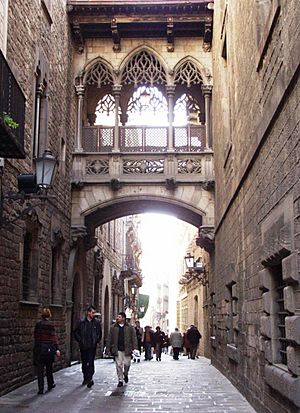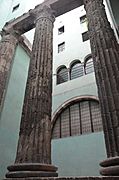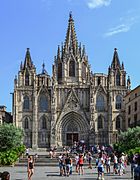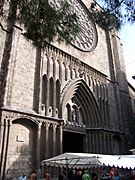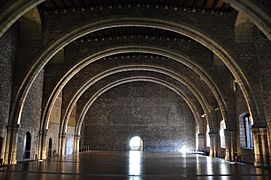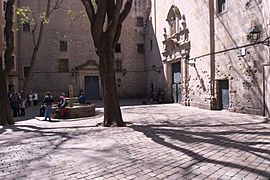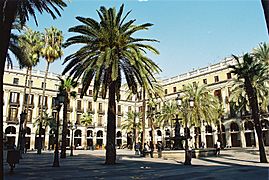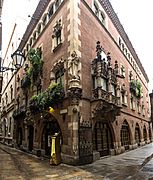Gothic Quarter, Barcelona facts for kids
The Gothic Quarter (also called Barri Gòtic in Catalan) is the very old center of Barcelona. It's a special part of the city where history comes alive! This area stretches from La Rambla to Via Laietana. It also goes from the Mediterranean Sea up to Ronda de Sant Pere. It is part of the Ciutat Vella district.
This quarter has the oldest parts of Barcelona. You can still see pieces of the city's old Roman wall. There are also many important buildings from the Middle Ages. However, much of what you see today was built or changed in the 1800s and early 1900s. The medieval Jewish quarter, known as El Call, is found here. The old Sinagoga Major (main synagogue) is also in this area.
The Barri Gòtic has a maze-like street plan. Many small streets open up into lovely squares. Most of the quarter is closed to regular cars. Only service vehicles and taxis can usually drive there.
Contents
Discovering the Gothic Quarter's History
Even though it's called the Gothic Quarter, many famous Gothic buildings here are not truly from the Middle Ages. In the late 1800s and early 1900s, this area was completely changed. It went from a quiet neighborhood to a big tourist spot. This happened because of a huge restoration project. It was finished just in time for the 1929 International Exhibition.
This project helped Barcelona and the region of Catalonia look great to the world. More work on old buildings and new neo-Gothic structures continued until the 1960s. Neo-Gothic means "new Gothic." It is a style that looks like Gothic but was built much later.
Buildings with Neo-Gothic Additions
Several main buildings in the Gothic Quarter were rebuilt or changed with neo-Gothic parts. Here are some examples:
- The front of the Barcelona Cathedral: This part was built between 1882 and 1913. Architects Josep Oriol Mestres and August Font i Carreras added many Gothic-style details.
- The Centre Excursionista de Catalunya building: This is the Hiking Center of Catalonia. Lluís Domènech i Montaner worked on it in 1922. He added Gothic windows, battlements, and merlons (parts of a castle wall).
- The beautiful bridge over Carrer Bisbe: This Flamboyant-style bridge connects the Palau de la Generalitat and the Cases dels Canonges. It was newly built in 1928 by Joan Rubió.
- Casa Padellàs: This building is now the main office for the Museum of the History of Barcelona. It was built around 1500 on Carrer Mercaders. But it was moved to the Plaça del Rei in 1931, and its inside was rebuilt.
- Aguilar Palace: This is now the Museu Picasso (Picasso Museum) on Carrer Montcada. Adolf Florensa restored it in 1959. He added galleries with arches and Gothic windows.
- Pignatelli Palace: This building is now the Royal Artistic Circle of Barcelona. It was restored in 1970. Many Gothic windows were added, which were found in city storage.
Famous Places to See
Getting Around by Metro
You can easily reach the Gothic Quarter using Barcelona's Metro system:
- L4 (yellow line) has a station called Jaume I.
- L3 (green line) has stations called Liceu and Drassanes.
See also
 In Spanish: Barrio Gótico de Barcelona para niños
In Spanish: Barrio Gótico de Barcelona para niños
- Urban planning of Barcelona


